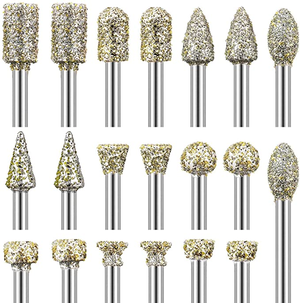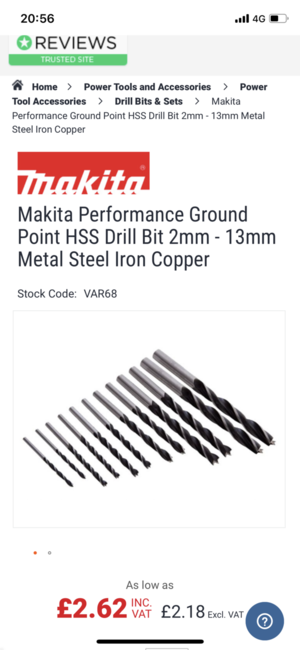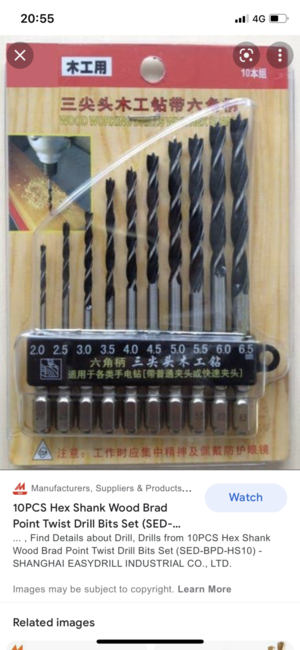I have a very basic question. Is there any standard way of cutting the holes in the main deck for the masts? I am working on the FAIR AMERICAN and have reached the point to where I need to test-fit the masts. On the first model I built, I actually used a drill press to make the holes (got some collective groans from the audience). I tried using a tapered round file, but the progress is very slow, and it would take forever. This is my first major build and I want to do it right.
You are using an out of date browser. It may not display this or other websites correctly.
You should upgrade or use an alternative browser.
You should upgrade or use an alternative browser.
Appreciate the input. Thanks.A diamond burr bit in a Dremel rotary can be used to remove wood fast. You start with a pilot hole drilled in the deck first, then widen it to the desired size and angle relative to the keel with the Dremel. Start widening with the pointed burr and finish with the cylindrical bit.
View attachment 317949
The way my father taught me to make a nice hole was to drill a small hole and then chuck up a rat tailed file in a drill and put it on reverse. Make sure it's in reverse. Drill away. It goes quite quickly. It does involve the purchase of a large rat tail and they ain't cheap. Also if you are drilling partners or such, start with a large piece of wood. drill out the hole and then cut the piece down to the final size. Les splitage that way.
Thanks, Don. I have a rat-tail file that might work. I bought a small set of burr bits, but I think the shank diameter is going to be too large for my rotary tool. Thanks a lot for the suggestion.The way my father taught me to make a nice hole was to drill a small hole and then chuck up a rat tailed file in a drill and put it on reverse. Make sure it's in reverse. Drill away. It goes quite quickly. It does involve the purchase of a large rat tail and they ain't cheap. Also if you are drilling partners or such, start with a large piece of wood. drill out the hole and then cut the piece down to the final size. Les splitage that way.
Even if you doesn’t get a very correct hole you can improve it covering the not smoothly drilled sides using a washer at the base of the mast .in the attachment are several examples which I used at different shipmodels.I have a very basic question. Is there any standard way of cutting the holes in the main deck for the masts? I am working on the FAIR AMERICAN and have reached the point to where I need to test-fit the masts. On the first model I built, I actually used a drill press to make the holes (got some collective groans from the audience). I tried using a tapered round file, but the progress is very slow, and it would take forever. This is my first major build and I want to do it right.
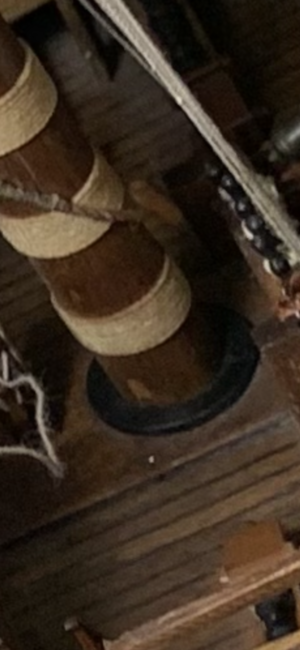
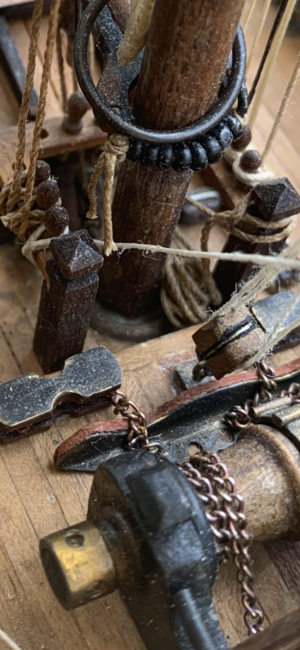
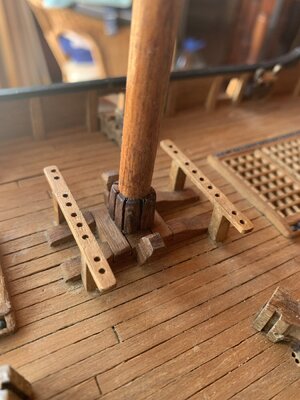
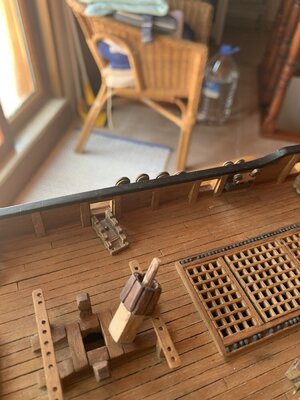
Korsan, thanks for the excellent idea.
You will never beat the use of a forstner bit for a job like this. Hold the drill steady and you can’t lose. There is no wobbling or drift from the bit.
Whiskers, Thanks for the input. I actually have a set. Need to see if I have one bit small enough for this project. Thanks again.
I just went searching for small brad point drills. I can't seem to find anything smaller than 3mm(1/8"). Do they make such a thing?
Smallest I've seen is 3/32" at Pan American Tool, but it costs $35.00.I just went searching for small brad point drills. I can't seem to find anything smaller than 3mm(1/8"). Do they make such a thing?
Last edited:
I've had mixed results with Brad points. The do great drilling into a solid piece of wood, nice smooth entry holes.
The problem I had was drilling into my planked deck. The wood tore a bit at the seam between the planks. I'm not sure if more glue at the seam would have helped or some other method. I've just been drilling the holes a size small and filing to final size and shape for angled masts or the bow sprit.
The problem I had was drilling into my planked deck. The wood tore a bit at the seam between the planks. I'm not sure if more glue at the seam would have helped or some other method. I've just been drilling the holes a size small and filing to final size and shape for angled masts or the bow sprit.
I've had issues drilling into planked decks also. The bit usually tears the crap out of the edges of planks or takes a chunk out of a plank or two. You have to save the bits of plank and attempt to patch the deck as good as you can. It's better to drill a pilot hole and file the hole to size or use a small diameter diamond burr to grind away the wood without chipping it. The nice thing about diamond burrs is they don't load up with sawdust like a sanding cylinder, and chunks of sawdust that do stick flake right off the bit easily.I've had mixed results with Brad points. The do great drilling into a solid piece of wood, nice smooth entry holes.
The problem I had was drilling into my planked deck. The wood tore a bit at the seam between the planks. I'm not sure if more glue at the seam would have helped or some other method. I've just been drilling the holes a size small and filing to final size and shape for angled masts or the bow sprit.
Thanks, I won't bother with the brad points. I've managed for 60 years without them.
So did I tooThanks, I won't bother with the brad points. I've managed for 60 years without them.
- Joined
- Oct 15, 2017
- Messages
- 986
- Points
- 403

I always try to find a "better way" when taking on a new task. Sometimes because I've never done it before and need to "teach" myself. This always requires testing "off model" to prevent doing any damage.
When I drill holes of any diameter larger than 2-3mm, I tape over where I'm going to drill and place the hole target on the tape. This prevents the wood splintering around the edge of the hole. As someone noted, this may not be needed with drilling holes for masts as the mast collars can/may cover your rough edges.
With that said, the largest holes requiring drilling present the biggest challenge ,for me). I find it even more difficult and frustrating to attempt to manufacture a large hole with hand tools, rasps, files, etc. I just don't have that talent. I have found that step drill bits work well for me on larger holes. I find the center. Make a small indent with a punch. Drill a pilot hole, maybe 1-3mm, then drill down to the "step" on the bit that closely matches, but is smaller, than the diameter I need.
It may not be what others choose to do, but I thought I would share what has worked for me. I try to find processes that I can use an every project successfully. For me it's about feeling confident in the method and allows me to progress. I find that as modelers, we all stall in our progress when we are not sure of what to do next. Finding methods we prove work for us allow us to move forward with confidence, that is until the next problem, requiring a solution presents itself.
Here is the set I use.
Good luck!
Ken
When I drill holes of any diameter larger than 2-3mm, I tape over where I'm going to drill and place the hole target on the tape. This prevents the wood splintering around the edge of the hole. As someone noted, this may not be needed with drilling holes for masts as the mast collars can/may cover your rough edges.
With that said, the largest holes requiring drilling present the biggest challenge ,for me). I find it even more difficult and frustrating to attempt to manufacture a large hole with hand tools, rasps, files, etc. I just don't have that talent. I have found that step drill bits work well for me on larger holes. I find the center. Make a small indent with a punch. Drill a pilot hole, maybe 1-3mm, then drill down to the "step" on the bit that closely matches, but is smaller, than the diameter I need.
It may not be what others choose to do, but I thought I would share what has worked for me. I try to find processes that I can use an every project successfully. For me it's about feeling confident in the method and allows me to progress. I find that as modelers, we all stall in our progress when we are not sure of what to do next. Finding methods we prove work for us allow us to move forward with confidence, that is until the next problem, requiring a solution presents itself.

Here is the set I use.
Good luck!
Ken
First, most masts in sailing ships are not held in place by the planking. There is almost always clearance between the planking and the mast. For decks which actually support the mast, a structure surrounds it, with often tapered shims to locate it. Also, there is usually some sort of wood mast ring (mast coat) surrounding it, to close off the opening. This can cover any irregularities or oversize hold. So, normally you will never see the actual hole drilled to accept the mast. Having the mast coat also allows final movement and alignment of the mast.
As to drilling and increasing the size of holes, I had surprisingly good luck using stepped drill bits. It wasn't in a deck, but I was quite surprised how easy the hole drilled and how clean it was. If it doesn't give you the exact size, they make stepless drill bits as well, or you can file the hole slightly larger.
As to drilling and increasing the size of holes, I had surprisingly good luck using stepped drill bits. It wasn't in a deck, but I was quite surprised how easy the hole drilled and how clean it was. If it doesn't give you the exact size, they make stepless drill bits as well, or you can file the hole slightly larger.
Those stepless drills look handy 
Yeah, I always thought they'd be hard to use or make ragged holes, but they work surprisingly well. Of course in thick materials, you end up with a stepped hole, but at least the outer hole is round and can be filed.Those stepless drills look handy



